 THE MINERAL UVAROVITE
THE MINERAL UVAROVITE
- Chemistry: Ca3Cr2(SiO4)3, Calcium Chromium Silicate
- Class: Silicates
- Subclass: Nesosilicates
- Group: Garnets
- Uses: Gemstones and mineral specimens
- See our natural
Uvarovite Mineral Specimens
For Garnet Jewelry, see:GARNET JEWELRY
PHYSICAL CHARACTERISTICS:
- Color is a bright green.
- Luster is vitreous.
- Transparency crystals are transparent to translucent.
- Crystal System is isometric; 4/m bar 3 2/m
- Crystal Habits include the typical rhombic dodecahedron. But more commonly is found as the 24 sided trapezohedron. Combinations of these forms are common. Massive and granular occurrences are also seen.
- Cleavage is absent.
- Fracture is conchoidal.
- Hardness is 6.5 - 7
- Specific Gravity is approximately 3.8 or less (above average for translucent minerals).
- Streak is white.
- Associated Minerals are chromite and serpentine.
- Other Characteristics: index of refraction is 1.86. dodecahedral faces may show striations.
- Notable Occurrences are Finland; Sarany, Ural Mountains Region, Russia; California and South Africa.
- Best Field Indicators are crystal habit, color, locality and hardness.
 Amethyst Galleries' Mineral Gallery MINERALS |
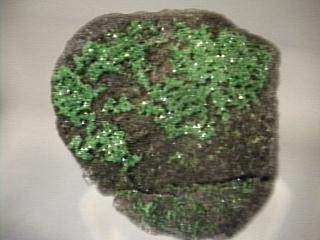
UVAROVITE specimen uva-1
$ 39.00
$ 39.00
Dims: 1-3/4" x 1-1/2" x 5/16"
Wt: 1.1 oz
Sarany, Ural Mountains, Russia
By far the most expensive variety of Garnet, the Uvarovite crystals on this specimen are microscopic in size. Crystals are small as a rule and rarely ever exceed 1/8 inch in diameter. Their emerald-green color is evident, though, and along with its commonly dodecahedral or trapezohedral shape, convince the collector. This material is very difficult to get, and is definitely sought after in collectors' circles.

uva-1 ($ 39.00)
Sarany, Ural Mountains, Russia
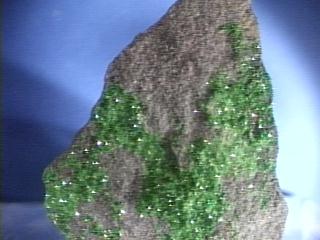
UVAROVITE specimen uva-2
$ 85.00
$ 85.00
Dims: 3-1/2" x 3" x 5/8"
Wt: 6.7 oz
Sarany, Ural Mountains, Russia
Though it's hard to see their crystal structures without a microscope, their size and emerald-green color are the best identifiers to Uvarovite, the main attraction of this specimen. The crystals are each less than 1 millimeter in diameter, and lay on top of what could be a variety of Gneiss, but I would guess to be a form of chromic Serpentine. Specimens like these are rare, and thus are choice collector's items.
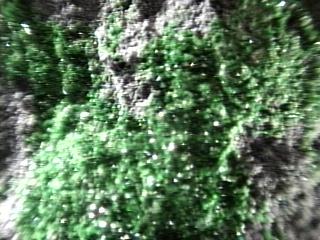

uva-2 ($ 85.00)
Sarany, Ural Mountains, Russia
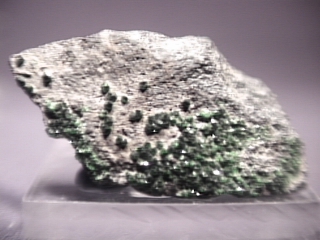
UVAROVITE specimen uva-3
$ 25.00
$ 25.00
Dims: 1.7" x 0.9" x 0.3" (4.3 x 2.3 x 0.8 cm)
Wt: 12.6 g
Sarany, Ural Mountains, Russia
The igneous host rock of this specimen holds a few dozen Uvarovite garnets. Though they are very small and show some noticeable damage, they are some of the larger Uvarovites that I have seen from this locality, as some of the crystals are 1 mm or so in diameter. They are large enough so that one doesn't need magnification to discern their excellent dodecahedral form or their vitreous luster. Their color is a very deep green that approaches that of emerald, and they are translucent at the least. The nicest aspect of this specimen is the fact that the crystals are separated enough so that one can easily discern their individual form, which is not spoiled due to intergrowth.

uva-3 ($ 25.00)
Sarany, Ural Mountains, Russia
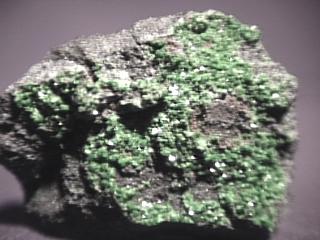
UVAROVITE specimen uva-4
$ 41.00
$ 41.00
Dims: 2.0" x 1.2" x 0.5" (5.1 x 3.0 x 1.3 cm)
Wt: 1.58 oz. (44.8 g)
Sarany, Ural Mountains, Russia
Scores of tiny Uvarovite crystals partially coat one side of the flat, gray host rock of this specimen. Most are less than 1 mm in diameter, but one can see individual crystal faces that are at least that long. These faces correspond to the crystals' dodecahedral form, though it is quite difficult to determine their individual shapes due to their tiny size and their heavy intergrowth. All have beautiful moderately deep green color that approaches that of emerald, and all are at least translucent; the brightness of their color may be caused by tiny internal fractures in each crystal. The dark gray host rock on which they rest has a flat face cut into its underside. It is a very pretty specimen.

uva-4 ($ 41.00)
Sarany, Ural Mountains, Russia
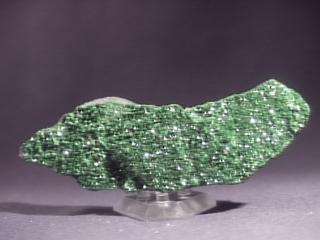
$ 180.00
Dims: 4.8" x 1.7" x 0.8" (12.2 x 4.3 x 2.0 cm)
Wt: 5.46 oz. (155.0 g)
Sarany, Ural Mountains, Russia
Hundreds of emerald-green Uvarovite crystals rest on the dark gray, igneous host rock of this specimen. They range in diameter from less than 1 mm to nearly 2 mm, and are generally in good condition, though there are noticeable patches of damage to the crust that they form. All have the deep green coloration and show a vitreous luster and slight translucence, though some of the crystals may actually be transparent. Where undamaged, the crystals show the dodecahedral form that is standard for Uvarovite, though their intergrowth renders most of them incomplete. It is a very pretty specimen that shows a lot of the wonderful green color that one expects.
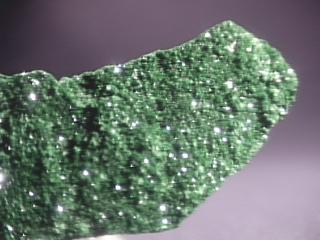

Sarany, Ural Mountains, Russia
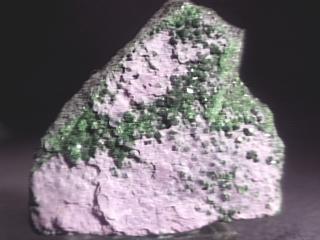
UVAROVITE specimen uva-6
$ 125.00
$ 125.00
Dims: 2.0" x 1.8" x 0.4" (5.1 x 4.6 x 1.0 cm)
Wt: 1.75 oz. (49.6 g)
Sarany, Ural Mountains, Russia
This small hand specimen consists of a flat slab of dark gray, igneous host rock that is partially coated with a few dozen dodecahedral Uvarovite crystals. These crystals do not generally exceed 1 mm in diameter, and are generally in moderately good condition, though several of them show considerable damage and are incomplete. They have the standard emerald-green color that one expects, are translucent to transparent, and have a bright, vitreous luster. Their form, where undamaged, is quite good, though intergrowth prevents any of the crystals from being more than 50% complete. An odd addition to this piece is the presence of a dull, massive, fuschia-colored material that partially coats the Uvarovite crust, obscuring over 50% of the crystals. It has the general color of the mineral charoite, but is soft enough to be scratched with a fingernail. According to a knowledgeable browser who just wrote to me (thanks, Tim!), the material is likely stichtite, a hydrated magnesium chromium carbonate hydroxide.

uva-6 ($125.00)
Sarany, Ural Mountains, Russia
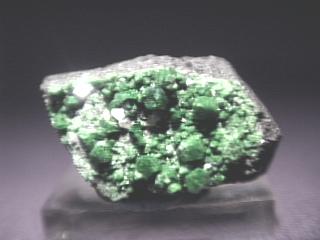
UVAROVITE specimen uva-7
$ 50.00
$ 50.00
Dims: 1.3" x 0.7" x 0.5" (3.3 x 1.8 x 1.3 cm)
Wt: 12.9 g
Sarany, Ural Mountains, Russia
Though this is one of the smallest specimens that we have available, it has some of the largest Uvarovite crystals on it that I have ever seen! There are seven discernable crystals that measure at least 0.12" (3 mm) in diameter, and many more that are smaller. Four of the larger crystals are either damaged or incomplete, but the rest are in excellent condition. All of them have good dodecahedral form and a deep, emerald-green coloration, and show moderate translucence. They are partially embedded in a small, flat slab of the dark gray host rock on which Russian Uvarovite crystals are usually found. Even with its damage, this specimen impresses me.

uva-7 ($ 50.00)
Sarany, Ural Mountains, Russia
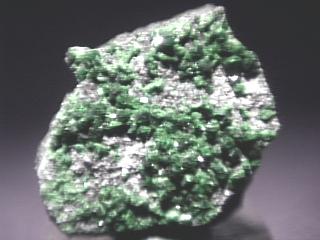
UVAROVITE specimen uva-8
$ 45.00
$ 45.00
Dims: 1.3" x 1.1" x 0.4" (3.3 x 2.8 x 1.0 cm)
Wt: 20.6 g
Sarany, Ural Mountains, Russia
A few dozen tiny Uvarovite crystals are embedded in the small, dark gray, igneous host rock of this specimen. The crystals are generally in moderately good condition, as there appears to be a substantial amount of damage to some of the crystals, which are incomplete. They range from less than 1 mm to at least 2 mm in diameter and have the dodecahedral form that is common for this mineral. Their color is a deep green, their luster is vitreous, and they are transparent but highly internally-fractured. I am impressed with the color of the intact crystals on this specimen; it appears to be deeper than that of most pieces that I have seen.

uva-8 ($ 45.00)
Sarany, Ural Mountains, Russia
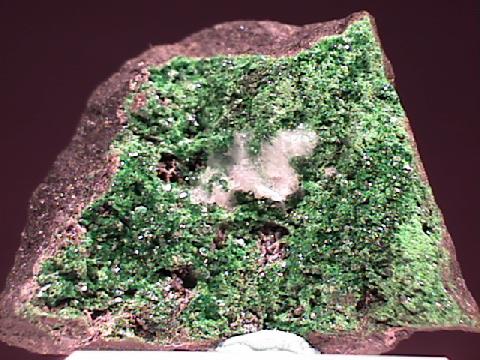
UVAROVITE specimen uva-9
$ 25.00
$ 25.00
Dims: 1.6 x 1.1 x 0.4" (4.1 x 2.8 x 1.0 cm)
Wt: 16.9 g
Sarany, Ural Mountains, Russia
This thumbnail specimen consists of a thin, partly-cut slab of dark gray base rock on which rests a crust made up of scores of tiny Uvarovite crystals. Most are nearly microscopic, though a few approach 1 or 2 mm in diameter, and a substantial part of the crust is damaged. Those crystals that are intact have excellent dodecahedral form, with well-defined edges and clean faces that possess the standard vitreous luster. All have the classic emerald-green color, and many are transparent and quite clear. There appears to be a small amount of white calcite coating part of the crust.

uva-9 ($ 25.00)
Sarany, Ural Mountains, Russia
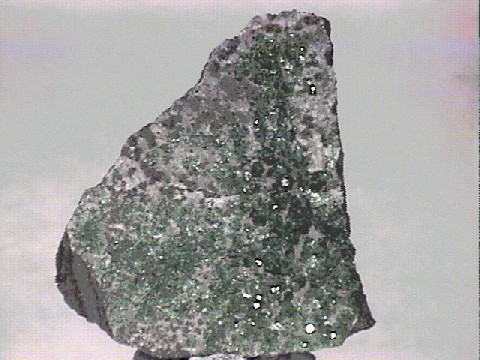
UVAROVITE specimen uva-10
$ 25.00
$ 25.00
Dims: 2.0 x 1.6 x 0.3" (5.1 x 4.2 x 0.9 cm)
Wt: 1.2 oz. (33 g)
Saranskoe, Ural Mountains, Russia
This flat hand specimen consists of a dark gray base on which rest many tiny Uvarovite crystals. Most of these crystals are crushed, but at least 20 are still intact. None of them exceed 2 mm in diameter, and most are smaller than 1 mm. All have excellent dodecahedral form and the standard emerald-green color and vitreous luster, and are at least dimly transparent.

uva-10 ($ 25.00)
Saranskoe, Ural Mountains, Russia
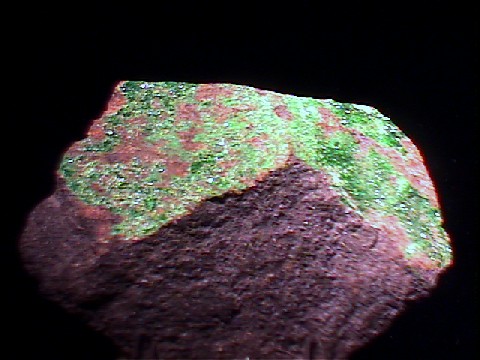
UVAROVITE specimen uva-11
$ 90.00
$ 90.00
Dims: 3.8 x 2.7 x 1.0" (9.7 x 7.0 x 2.6 cm)
Wt: 7.7 oz. (217 g)
Saranskoe, Ural Mountains, Russia
Countless tiny Uvarovites rest on the dark gray base rock of this cabinet specimen. Though there are several areas of damage, most of the crystals are in excellent condition. They do not exceed 1 mm in diameter as a rule, and all have excellent dodecahedral form. Their emerald-green color and vitreous luster are standard for the specie, and all are likely transparent to a degree.
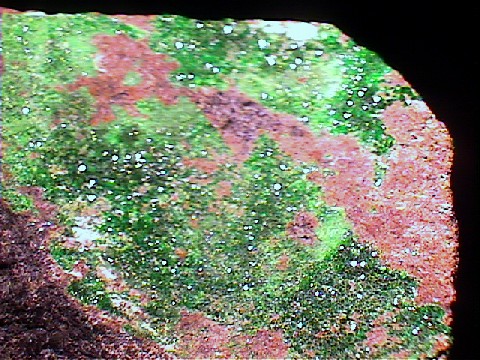

uva-11 ($ 90.00)
Saranskoe, Ural Mountains, Russia
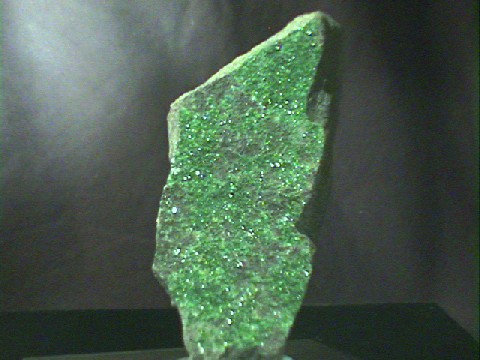
UVAROVITE specimen uva-12
$ 60.00
$ 60.00
Dims: 4.4 x 1.9 x 0.6" (11.1 x 4.9 x 1.5 cm)
Wt: 4.7 oz. (133 g)
Saranskoe, Ural Mountains, Russia
The dark gray base rock of this specimen is partly covered on one side by a crust of very tiny Uvarovite crystals. These crystals measure considerably less than 1 mm in diameter, and are so small that at least 10-power magnification is needed for proper study. The crust is in good condition, however, showing only one or two small areas of damage. Though difficult to study, their dodecahedral form appears to be incomplete but good, and all have the standard deep emerald green color and vitreous luster of the specie.
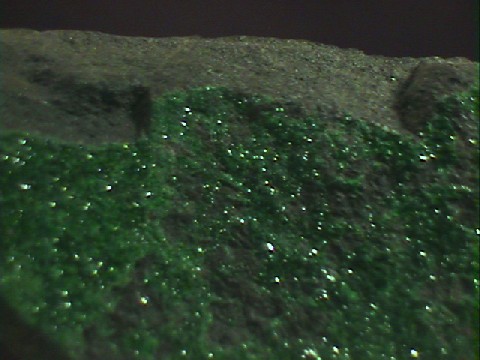

uva-12 ($ 60.00)
Saranskoe, Ural Mountains, Russia
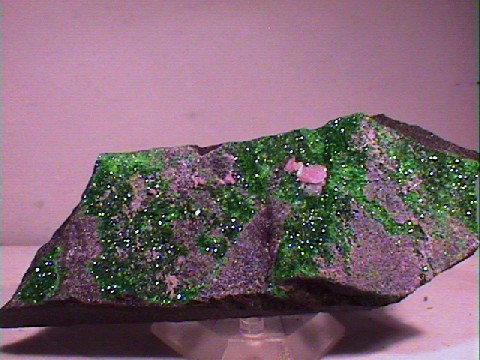
UVAROVITE specimen uva-13
$ 36.00
$ 36.00
Dims: 4.4 x 2.1 x 0.6" (11.2 x 5.4 x 1.5 cm)
Wt: 4.8 oz. (137 g)
Sarany, Ural Mountains, Russia
Crusts of fine Uvarovite crystals partly coat the igneous base of this cabinet piece. These crystals do not reach more than 1mm in diameter but are in excellent condition, showing almost no damage. All have the classic dodecahedral form, emerald-green color and vitreous luster of the specie, and are likely at least dimly transparent. They are accompanied by a small amount of what looks like pink calcite - I am really not sure what the material is, however.

uva-13 ($ 36.00)
Sarany, Ural Mountains, Russia
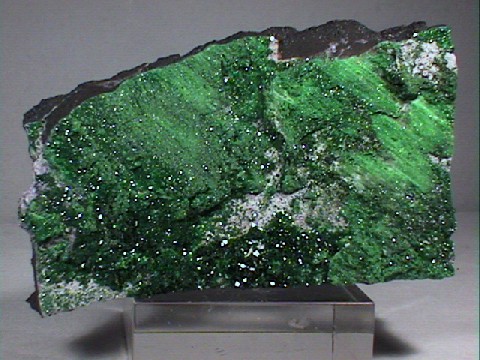
UVAROVITE specimen uva-14
$ 60.00
$ 60.00
Dims:2.8x1.7x0.8" (7.1x4.3x2.0 cm)
Wt: 4.8oz. (135g)
Sarany, Ural, Russia
The face of one side of this sample is covered with uvarovite garnets, from microscopic in size up to 1/16 inch (0.16cm). The color of these garnets is an excellent bright emerald green, and there is no damage to this specimen. With the aid of a loupe, one can see that the crystals show excellent dodecahedral habit.
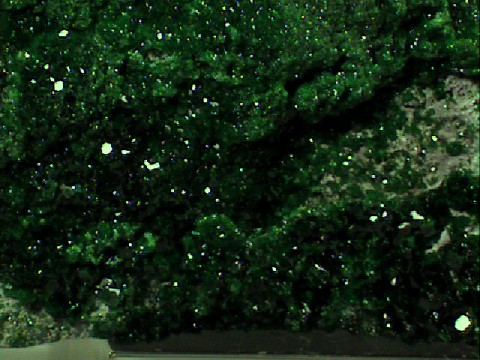

uva-14 ($ 60.00)
Sarany, Ural, Russia
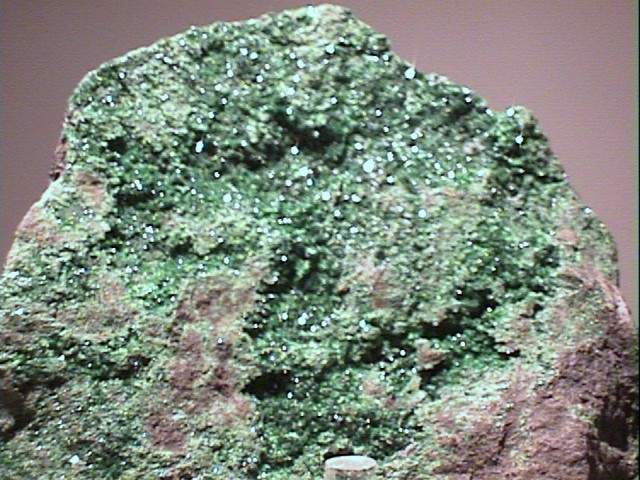
UVAROVITE specimen uva-15
$ 40.00
$ 40.00
Dims: 4.05x2.76x0.60" (10.28x7.00x1.53cm)
Wt: 6.81oz (192.7g)
Saranovsk Mine, Ural, Russia
This hand specimen of uvarovite garnet has the usual intense green color in thousands of tiny crystals coating much of one side of this specimen. A loupe reveals that the crystals are transparent and come in two shapes, one being traditional dodecahedrons, but the others appear to be rhombohedrons and are the same green, but have a darker luster.

uva-15 ($ 40.00)
Saranovsk Mine, Ural, Russia
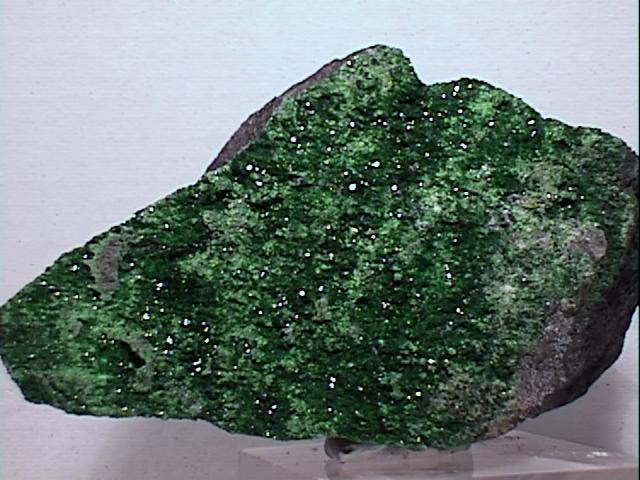
UVAROVITE specimen uva-16
$ 35.00
$ 35.00
Dims: 3.93x2.18x0.73" (9.97x5.53x1.87cm)
Wt: 6.45oz (182.4g)
Saranovsk mine, Ural, Russia
One surface of this rock is coated with a druze of bright green uvarovite garnet crystals. While all of these crystals are tiny, they have a variety of sizes and the color varies in depth, as the largest crystals are transparent, vitreous, and well-formed, while the smaller crystals appear less intensely green, and a sizable fraction have a greenish-white appearance. It appears that the uvarovite coated a narrow crevice in the host rock, and this is one side of the crevice. The lighter colors (due to fractures and incomplete crystal surfaces) are the contact surfaces where the two sides touched.
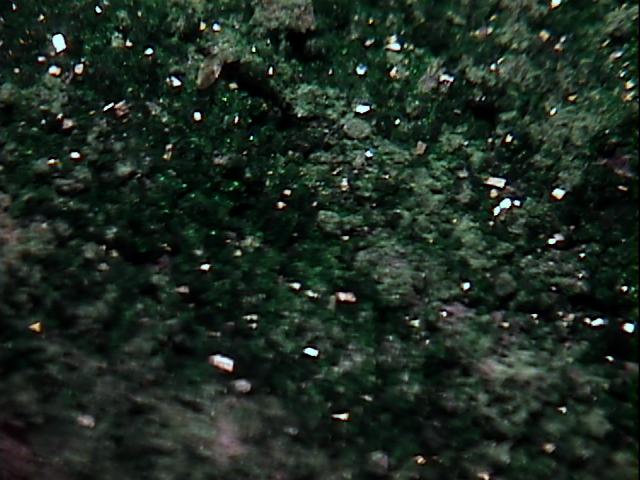

uva-16 ($ 35.00)
Saranovsk mine, Ural, Russia
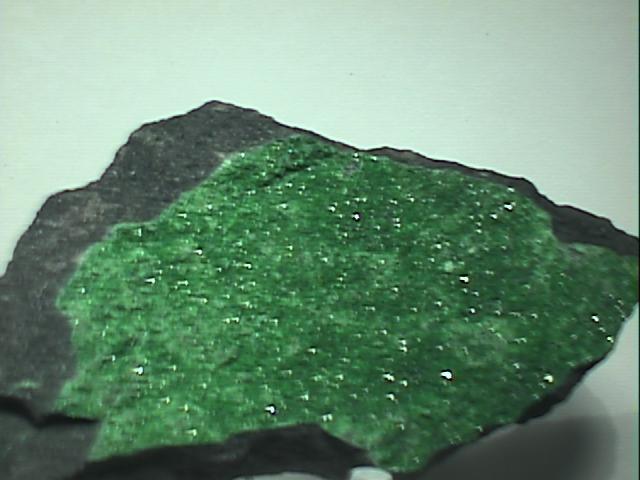
UVAROVITE specimen uva-17
$ 30.00
$ 30.00
Dims: 3.87x1.98x0.49" (9.84x5.02x1.25cm)
Wt: 5.48oz (155.2g)
Saranovsk Mine, Ural, Russia
An intense green coating of tiny uvarovite crystals covers one surface of this specimen. They are large enough to sparkle beautifully, but too small to examine without a loupe. The color is an excellent deep green, and the individual crystals are transparent. The lighter looking areas are composed of smaller crystals, and there are several areas of contact damage, where the crevice was too narrow and the sides touched, resulting in a flattened area with incomplete crystals. Still, the specimen is very pretty.
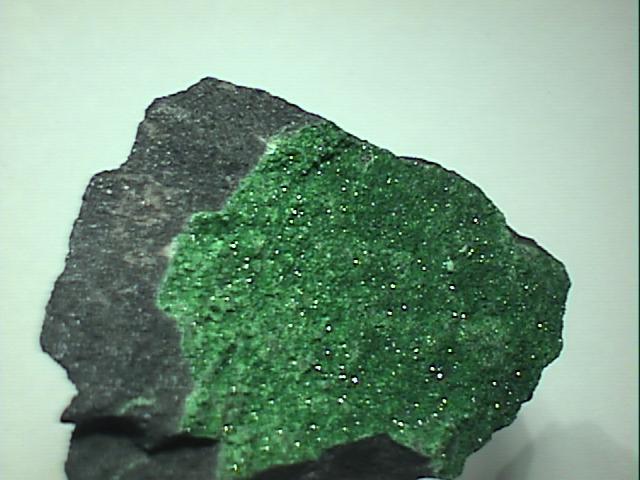

uva-17 ($ 30.00)
Saranovsk Mine, Ural, Russia